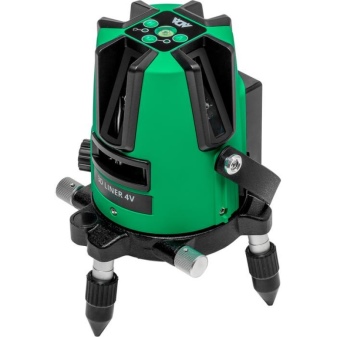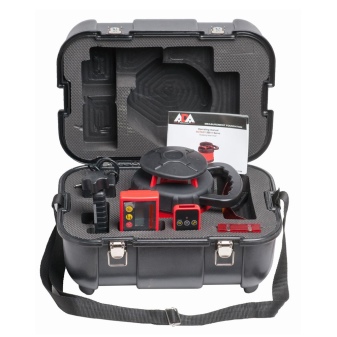Levels ADA Instruments

Level - a device widely used during work, one way or another taking into account the terrain. This is geodetic survey, and construction, laying of foundations and walls. The level, which allows you to check how two different points on the ground relate in height, is indispensable in the design of various communication systems - highways, pipelines, power lines. It is also often used in the assembly of prefabricated structures (eg furniture).
Levels are available in different configurations and for different purposes. They can be professional - in this case they are more expensive, provide greater functionality and accuracy. There are household models on sale for household use, which can be purchased at a more affordable price.



One of the leading manufacturers producing levels is ADA Instruments.
About the company and products
ADA Instruments has been producing measuring instruments for engineers, surveyors and builders since 2008.
The range includes various laser levels, rangefinders, levels and theodolites.

There are other useful tools in these areas, such as moisture meters, electronic levels, and calipers, which underscore ADA's vast experience in instrumentation design.
Production is located in Europe and Asia. The brand's products have European quality and the advantage of wide distribution in the world market, which makes them available for ordering or buying in any of the dealer stores, including in Russia.
If your goal is to choose a quality level, you will soon notice that customer reviews of ADA products are overwhelmingly positive. Levels and leveling rods supplied under this trademark, laser and optical levels, measuring devices (laser tape measures) and for marking are considered to be of the highest quality on the market. That's why modern ADA instrument models are in high demand.

Although only eleven years have passed since the registration of the brand, both amateurs and professionals alike note an important feature of ADA measuring instruments - their high accuracy. Decoding of the name ADA - Additional Accuracy, or additional accuracy. The quality of workmanship and the use of modern electronic reading devices allowed the developers to achieve the minimum error of the devices.
Of course, ADA products don't go on sale right away. Instruments that come off the assembly line must be tested and verified for calibration and accuracy, this applies to any production model, not just custom-made instruments. Thus, when buying a tool from an authorized dealer of this company, you can be sure that it meets the current technical specifications, including Russian GOST standards.
Levels from this manufacturer are supplied in a wide variety of designs, configurations and meet various needs. For professional purposes, there are devices based on optical determination of heights, they have the highest accuracy. For less complex tasks, laser-type levels are offered, which are cheaper.


Varieties of levels
Levels are intended for relative estimation of the height of two different points.
Optical
The level, based on the optical principle of action, was invented a long time ago and initially had a fairly simple design.Modern devices of this type have received various improvements and make it possible to carry out geodetic surveying and solve other problems related to the estimation of heights with great accuracy.
They usually have a tripod to which they are attached with special screws. To increase the viewing angle, the level can be rotated on a tripod in the horizontal plane. The sensitive level is an important component of the instrument. Some models are equipped with a distance meter.


When carrying out geodetic works related to the calculation of the height difference between two points, the technical capabilities of the device should be taken into account. It is the accuracy, expressed in millimeters (fractions of a millimeter) per kilometer, the degree of magnification that its telescope provides. An important role is played by a compensator - a technical unit designed to automatically level the level.
In terms of accuracy, levels with an optical principle of operation are divided into 3 categories.
- Instruments with high precision. Their error does not exceed 0.5 mm per 1 km.
- Levels with a level of accuracy suitable for construction and engineering design work. They allow leveling with an accuracy of 3 mm per km.
- Technical levels, which are also used in design and construction, but it should be borne in mind that they provide an accuracy of no more than 10 mm per 1 km.


Let's consider in more detail the design of this type of levels. Their main part is a telescope, the main technical parameter of which is the magnification ratio. For example, 24x and 32x magnification provides more flexibility and greater comfort than 20x magnification. Low magnification telescopes can cause eye strain with prolonged use.
All modern optical models of levels have a compensator. It is a unit that improves accuracy by automatically aligning the instrument. The axis on which the device is installed must be aligned so that the telescope looks “into the horizon” and the compensator maintains the correct correction of its tilt angle.

You can easily tell if a particular model is equipped with an expansion joint by the “K” marking.
Since levels in this category are often used by surveyors and builders in the field, you should choose a device with a high-quality protective case. VAll levels of ADA Instruments are provided with increased protection against mechanical influences, dust, vibration and humidity.
A serious advantage of optical devices is their resistance to temperature extremes in a wide range, because there are no electronic microcircuits in their design.
For to set the telescope in the right direction, the level is equipped with convenient guide screws... All models considered here have an ergonomic design of guide screws, the work with which is not difficult at any time of the year and in any weather.


Laser
Despite the fact that the design of laser levels includes quite expensive components, now there are many models for household use on sale that are available at low prices.
The laser is very convenient to use for leveling. The laser beam, focused by the optical system of the level, is not scattered, and therefore the device has a sufficiently large range. It is projected onto a distant object in the form of a point, so that you can easily visually estimate the difference in height.
There are two types of devices in this category, differing in the design of the optical system and how many LEDs are installed in them.



Prismatic
Their advantages are lower price, long service life. Due to their simple design, they are reliable and at the same time provide a good level of measurement accuracy.
The essence of the device lies in the fact that a laser beam emanating from an LED or several LEDs is collected into focus using a prism.

There are usually two prisms, allowing you to transform the light into two perpendicular planes. One is for horizontal layout and the other is for vertical layout.
Prismatic levels are very convenient for indoor construction work. Due to their availability, they are often purchased by builders or for household work.
The devices of the prismatic type have one drawback - a short range of action, which does not exceed 100 m. Therefore a rotary laser can be used to assess the difference between more distant points.

Rotary
Structurally, it is more complex than a prism one - the projection of the laser in it is provided by the rotation of the LED. Its range - up to 500 m
Another major advantage of rotary levels is the full sweep angle (360 degrees). It can be used to level in all directions, while the laser plane of prism levels has a sweep angle of no more than 120 degrees.


Both rotary and prism levels are also equipped with compensators for automatic leveling. In this case, two types of alignment systems are used: electronic and damper. They maintain the horizon with a maximum deviation of 5 degrees on average.
Please note that all lasers require a power supply for LEDs and electronics. For this, replaceable batteries and accumulators are used.

Their housing must provide increased protection against external influences. The models considered here have an IP54 or IP66 protection class, that is, their case effectively protects the microcircuits from dust and moisture. You just have to make sure that the device is not operated at extreme temperatures (-40 or + 50C).
Popular models
This overview includes models that represent the most logical choice for a wide range of level users.
Cube Mini Basic Edition belongs to the Ada laser levels for the consumer segment. They are great for leveling floors, parquet and tiles.

When installing furniture, this level is also very convenient to use. This model is also used for more complex tasks in the construction and installation of various structures and finishes. It has auto-leveling with a range of + -3 degrees, range - 20 m, accuracy - 0.2 mm / m.
Another budget option is 2D Basic Level, model with two laser planes (horizontal has a scan angle of 180 degrees, vertical - 160).
It has an Outdoor function that allows you to use a radiation receiver and thereby increase the range up to 40 m.

Model Ada Cube 3D Professional Edition gives you more flexibility when measuring and marking by projecting one horizontal line and two vertical ones. It has a battery saving mode, automatic leveling and simple one-button operation. There is a beep function that warns of excessive deviation from the horizon.


In the mode of operation with a radiation receiver, the operating range of this device can be increased up to 70 m. The accuracy is the same as that of the previously considered models.
If you are looking for a more professional optical instrument, then this may be the right one for you. model ADA Ruber-X32... It is more expensive than the ones described above, but provides higher accuracy. The level has a telescope with 32x magnification, which provides a high level of comfort when working


The device is unpretentious and can be used in any weather. The maximum deflection of the compensator is 0.3 degrees, the accuracy is 1.5 mm / km.
Operating tips
- When using devices with a laser, make sure that there are no objects in the path of the beam (so that the beam is not interrupted). It is recommended to choose the correct distance to the object corresponding to the declared range of the level. Otherwise, the level will be hard to see.
- Be sure to make sure that the level is leveled (installed on a horizontal plane or on a tripod).During shooting, the level is rigidly fixed.
- Before shooting, level the level on the horizon, focusing on the compensator signal, if there is such a function, or on the built-in bubble level.
- Laser devices can be hazardous to health. Avoid eye contact with the laser (both yourself and other people and animals).
- Laser models require timely battery replacement. In the case of long-term work, operation from the mains is allowed.


Laser levels of the CUBE series of the ADA Instruments trademark.













The comment was sent successfully.